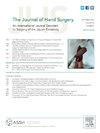A Comparison of Patient Characteristics and Outcomes Between Patients Receiving Flexor Digitorum Superficialis Slip Excision or Isolated A1 Pulley Release for Trigger Finger
IF 2.1
2区 医学
Q2 ORTHOPEDICS
引用次数: 0
Abstract
Purpose
Resection of the radial or ulnar slip of the flexor digitorum superficialis (FDS) tendon is a known treatment option for persistent trigger finger. Risk factors for undergoing FDS slip excision are unclear. We hypothesized that patients who underwent A1 pulley release with FDS slip excision secondary to persistent triggering would have a higher comorbidity burden compared to those receiving A1 pulley release alone.
Methods
We identified all adult patients who underwent A1 pulley release with FDS slip excision because of persistent triggering either intraoperatively or postoperatively from 2018 to 2023. We selected a 3:1 age- and sex-matched control group who underwent isolated A1 pulley release. Charts were retrospectively reviewed for demographics, selected comorbidities, trigger finger history, and postoperative course. We performed multivariable logistic regression to assess the probability of FDS slip excision after adjusting for several variables that were significant in bivariate comparisons.
Results
We identified 48 patients who underwent A1 pulley release with FDS slip excision and 144 controls. Our multivariable model showed that patients with additional trigger fingers and a preoperative proximal interphalangeal (PIP) joint contracture were significantly more likely to undergo FDS slip excision.
Conclusions
Patients who underwent A1 pulley release with FDS slip excision were significantly more likely to have multiple trigger fingers or a preoperative PIP joint contracture. Clinicians should counsel patients with these risk factors regarding the potential for FDS slip excision in addition to A1 pulley release to alleviate triggering of the affected digit.
Type of study/level of evidence
Therapeutic III.
接受屈指肌浅层滑脱切除术或孤立 A1 滑轮松解术治疗扳机指的患者特征和疗效比较。
目的:已知切除屈指肌浅肌腱(FDS)的桡侧或尺侧滑脱是治疗顽固性扳机指的一种方法。接受 FDS 滑移切除术的风险因素尚不清楚。我们假设,与单纯接受 A1 滑轮松解术的患者相比,因顽固性扳机指而接受 A1 滑轮松解术并同时接受 FDS 滑脱切除术的患者的合并症负担更高:我们确定了2018年至2023年期间因术中或术后持续触发而接受A1滑轮松解术并行FDS滑脱切除术的所有成年患者。我们选择了年龄和性别匹配为 3:1 的对照组,他们接受了孤立的 A1 滑轮松解术。我们对病历进行了回顾性审查,以了解人口统计学、部分合并症、扳机指病史和术后病程。我们进行了多变量逻辑回归,以评估在调整了双变量比较中显著的几个变量后,FDS滑脱切除的概率:结果:我们确定了 48 名接受 A1 滑轮松解术并行 FDS 滑脱切除术的患者和 144 名对照组患者。我们的多变量模型显示,伴有其他扳机指和术前近端指间关节(PIP)挛缩的患者接受FDS滑脱切除术的几率明显更高:结论:接受 A1 滑轮松解术和 FDS 滑脱切除术的患者有多个扳机指或术前 PIP 关节挛缩的可能性明显更高。临床医生应向具有这些风险因素的患者提供咨询,使其了解在进行A1滑轮松解术的同时进行FDS滑脱切除术的可能性,以减轻受影响手指的触发:治疗 III.
本文章由计算机程序翻译,如有差异,请以英文原文为准。
求助全文
约1分钟内获得全文
求助全文
来源期刊
CiteScore
3.20
自引率
10.50%
发文量
402
审稿时长
12 weeks
期刊介绍:
The Journal of Hand Surgery publishes original, peer-reviewed articles related to the pathophysiology, diagnosis, and treatment of diseases and conditions of the upper extremity; these include both clinical and basic science studies, along with case reports. Special features include Review Articles (including Current Concepts and The Hand Surgery Landscape), Reviews of Books and Media, and Letters to the Editor.

 求助内容:
求助内容: 应助结果提醒方式:
应助结果提醒方式:


